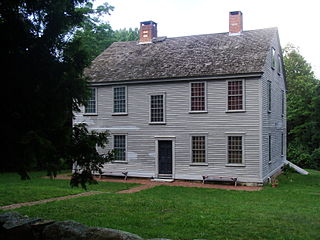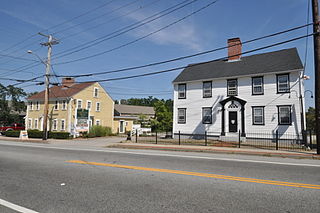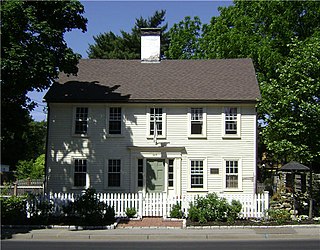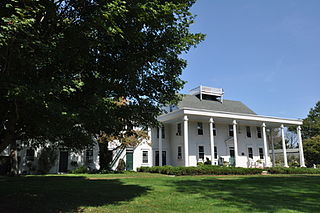
West Warwick is a town in Kent County, Rhode Island, United States. The population was 31,012 at the 2020 census.

The General Nathanael Greene Homestead, also known as Spell Hall, is a historic house at 20 Taft Street in Coventry, Rhode Island. It was the home of American Revolutionary War general Nathanael Greene from 1770 to 1776, and was owned afterwards by his brother Jacob Greene and his wife Margaret. The house is owned and operated by the General Nathanael Greene Homestead Association, a non-profit organization, and was opened as a museum in 1924.

The Apponaug Historic District is a 2-acre (0.81 ha) residential historic district in the central village of Warwick, Rhode Island, which is also known as Apponaug. It consists of five properties dating to no later than the early 19th century. These houses are a remnant of what was once a much larger collection of period houses in Apponaug, many of which have succumbed to modern 20th-century development of the area.

The Benjamin F. Greene House is an historic house at 85 Cross Street in Central Falls, Rhode Island, USA. The Second Empire house was designed by Clifton A. Hall and built by Wheeler & Marchant in 1868. The house is one of a small number of high-style mid-19th century houses in the city. It was built for Benjamin Franklin Greene, a second-generation mill owner in the Central Falls/Pawtucket area.

Budlong Farm is an historic farmhouse in Warwick, Rhode Island. It is a 1+1⁄2-story wood-frame house, with a gambrel roof and a large central chimney. Its current entrance is asymmetrically placed on the north facade, although the original main entry was on the south side. The house was probably built sometime between 1700 and 1720 by John Budlong, whose family was one of the first to settle the area after King Philip's War. The property is a rare local example of architecture to survive from that period.

The Cowesett Pound is an historic animal pound on Cowesett Road in Warwick, Rhode Island. The pound, a roughly square structure built of unmortarted fieldstone four to five feet in height, is estimated to have been built in 1742 by David Greene, although there was an older pound already at the site. Its walls were probably once topped by capstones, but only one of these survives. The entrance to the pound has a wooden gate added during a 20th-century restoration.

Forge Farm is an historic farm in Warwick, Rhode Island. Established in the mid-17th century by the Greene family, it is one of the oldest farms in Rhode Island. It was the birthplace of General Nathanael Greene, a prominent American general in the American Revolutionary War. The core of the main house was built in 1684 by James Greene, son of John Greene, who purchased the land from local Native Americans. It has been extended and altered numerous times in the 18th and 19th centuries. Nathanael Greene was born in this house in 1742, and the farm was owned for many years by Nathanael's brother Christopher, and wife, Deborah (Ward) Greene, daughter of Continental Congress member Samuel Ward.

The Forge Road Historic District is a historic district on Forge Road from Ives Road to the Potowomut River in Warwick, Rhode Island. Most of the district's nearly 200 acres (81 ha) are taken up by the Forge Farm, which lies south of Forge Road, is one of the oldest farms in Rhode Island, and was the birthplace of American Revolutionary War general Nathanael Greene. A memorial to Greene stands near the bridge crossing the Potowomut River. Opposite the farm on Forge Road stand four houses, all of which date to the late 18th to mid-19th century.

Captain Oliver Gardiner House is a historic house prominently located in Warwick, Rhode Island. Built about 1750, it is a 2+1⁄2-story wood-frame structure with a gambrel roof. Its main facade has six irregularly-spaced bays, with a centrally positioned entrance. The house is unusual for its period in that it has a large central hallway, a feature not commonly seen until the Federal period. Oliver Gardiner, its first owner, was a ship's captain.

The Caleb Gorton House is a historic 18th-century house located in Warwick, Rhode Island.

The Caleb Greene House is an historic house in Warwick, Rhode Island.

The Moses Greene House is an historic house in Warwick, Rhode Island. It is a 2+1⁄2-story wood-frame house with a large central chimney, and a rear ell. The main block was built c. 1750, and is one of Warwick's few surviving 18th-century houses. It is located on one of the first sites to be occupied by European settlers in Warwick, near one of its first sawmills. In 1750, Moses Greene built his home where Buckeye Brook meets Mill Cove. The home may have served a role in the Underground Railroad—a secret cellar room is accessed by a stone wall that slides aside on iron tracks. The room may have also been used by rum smugglers. The house was listed on the National Register of Historic Places in 1983.

The Richard Wickes Greene House is an historic house in Warwick, Rhode Island. The 2+1⁄2-story wood-frame house was built in 1849, and is an excellent local example of Georgian style. Richard Wickes Greene was a ship's captain who acquired the property from the Wickes family in 1826.

The Green–Bowen House is a historic house at 100 Mill Wheel Road in Warwick, Rhode Island, United States. It is a late-date stone-ender house, built c. 1715, and is the oldest surviving house of the locally historically prominent Greene family. It stands on land purchased by John Greene from local Native Americans in 1642, and was probably built by Fones Greene not long after he acquired the land in this area in the early 18th century. The house has a two-story main block, with two rooms on each floor, and its west wall and chimney are built of brick instead of stone. Shed-roof additions dating to 18th century were added abutting the west side and the rear. The property it stands on includes a 20th-century house, and a 19th-century barn and cottage.

The Greene–Durfee House is a historic house at 1272 West Shore Road in Warwick, Rhode Island.

Hopelands is a historic country estate on Wampanoag Road in Warwick, Rhode Island. It is now the campus of the Rocky Hill School, a private college preparatory school. The historic centerpiece of the estate is a Colonial Revival mansion house, whose western ell is a wood-frame structure built in 1686. This house and its associated 75-acre (30 ha) property became the center of one of Warwick's first country estates, when in 1793 a Federal-style house was built by Thomas P. Ives and Hope (Brown) Ives, to which the old building was attached. This was given extensive Colonial Revival treatment in 1885 by Moses Goddard. The estate was acquired by the Rocky Hill School in 1948.

The Oliver A. Wickes House is a historic house in Warwick, Rhode Island. The two-story stone structure was built in 1855 in a vernacular Federal/Greek Revival transitional style. The house is the only known period stone house in Warwick, and one of a very small number in the state. It has a four-bay main facade with a recessed entry framed by sidelights and a transom window.

The John R. Waterman House is an historic house at 100 Old Homestead Road in Warwick, Rhode Island. The 2+1⁄2-story wood-frame house was built c. 1800 by John R. Waterman, a prominent local farmer and politician. Waterman played a significant role in what became known as Dorr's Rebellion, an ultimately successful attempt to force liberalizing changes to the state constitution. The house is an excellent local example of Federal style, and is locally distinct for its use of paired interior chimneys instead of a large central one.

The Valley Queen Mill is an historic mill at 200 Providence Street in West Warwick, Rhode Island.

The Christopher Rhodes Greene House is a historic house at 2 Potter Court in Coventry, Rhode Island. The 2+1⁄2-story house, with a matching stable, was designed by the Providence firm of Stone & Carpenter, and built in 1883 for Christopher Rhodes Greene, one of the owners of the Clyde Bleach and Print Works, located about 1 mile (1.6 km) away on the Pawtuxet River. The house features the irregular massing with numerous projections and window shapes and sizes, and a wraparound porch with porte-cochere. The exterior is sheathed predominantly in wood clapboards on the lower level, and shingles cut in a variety of shapes on the upper levels. The main, south-facing, gable peak has more elaborate siding, along with false half-timbering and a medallion.






















